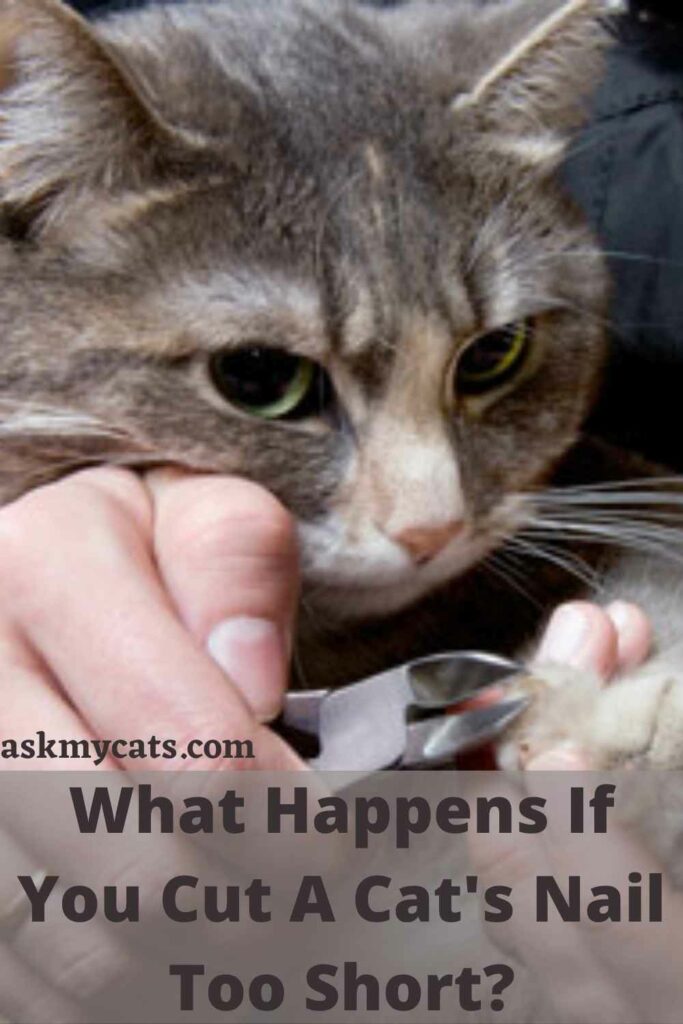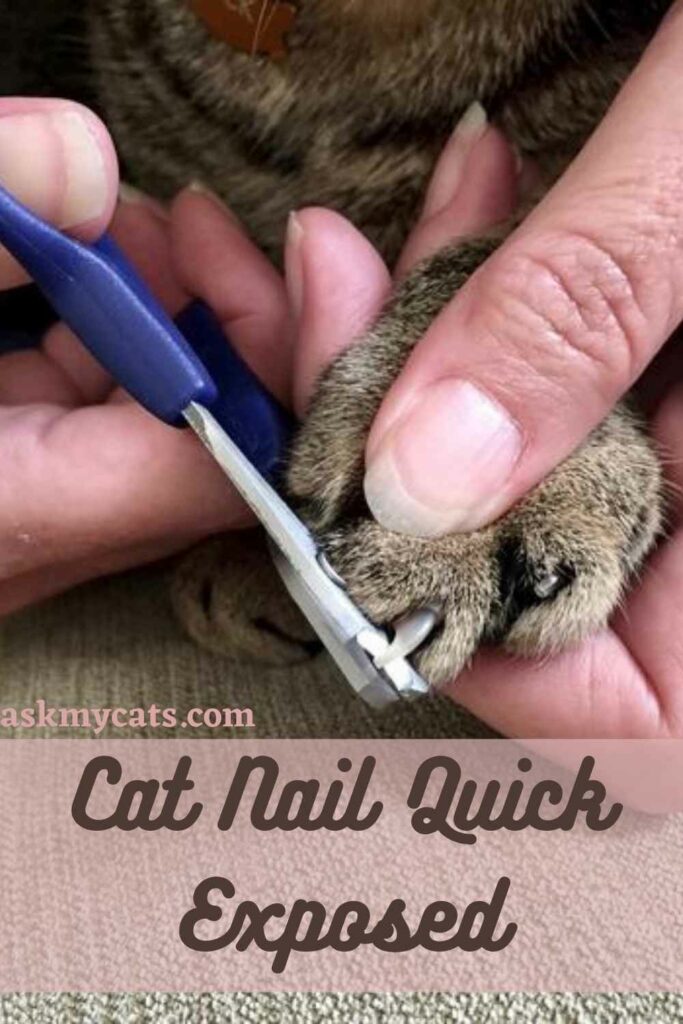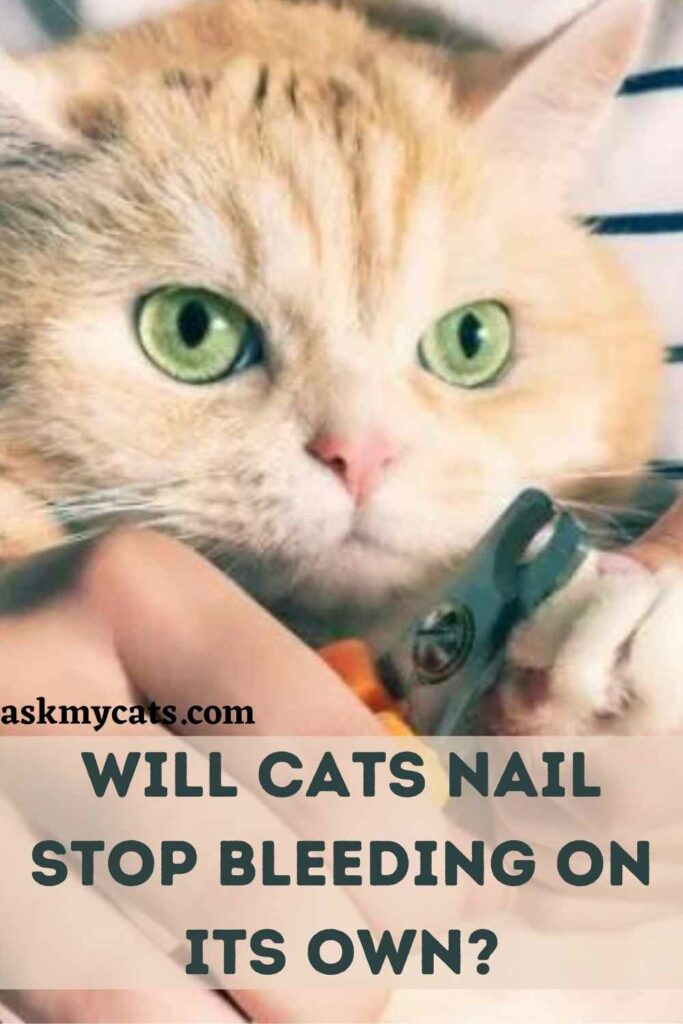Cats are commonly regarded as “self-grooming” pets, though they do require some grooming assistance from their owners. Trimming cats’ front nails are one of those points that they can’t do on their own.
While some indoor-only cats have their front claws de-clawed (that is, their claws have been removed by a veterinarian), cats’ rear claws are always left. Cat claws will need to be trimmed.
It is quite possible that you trimmed your cat’s nail a bit much more than required, and it starts bleeding. So, what to do if you cut your cat’s nail and it bleeds?
If you cut your cat’s nail and it bleeds, you must control bleeding by wrapping the foot in gauze or a towel and applying pressure to the injured toe. If the bleeding does not stop in 5-10 minutes, apply a styptic pencil, silver nitrate stick, or cauterizing powder to the nail.
This article will talk about how to cut your cat’s nails the right way and how to deal with a broken nail.


Give Your Cat the Perfect Day
Get the Free Ebook!
What Happens If You Cut A Cat’s Nail Too Short?
If you cut a cat’s nail too short it will hurt them and can also cause bleeding.

If you regularly trim your cat’s toenails, keep some cautery powder or styptic pencils on hand.
These items will put a stop to the bleeding. If you don’t have either of these items, rub the bleeding nail against an ice cube.
As a result, the blood vessels constrict and the bleeding slows. Cats lose a lot of blood when their toenails are broken or cut too short, but not enough to be dangerous.
Use cat nail clippers made exclusively for pets to trim your cat’s nails.
Because cat nails are circular, they are crushed when clipped with human nail clippers.
You won’t have a problem with bleeding if you look for the quick (the blood vessel in the nail that appears like a pink triangle) before cutting and cut below it.
If you can’t see your cat’s toenails, push the pad of each toe between your thumb and forefinger vertically: this will exteriorize the nail.
Trim your nails in the same order every time so you don’t miss any. Each front foot of a cat has five toes, and each hind foot has four.
To be safe, only cut the tip of the nail when you’re first starting out, and as your confidence grows, cut more. Every two to three weeks, toenails regrow.
Cat Nail Quick Exposed
If a cat nail quick is exposed it is possible that bleeding will occur.

The blood arteries, nerves, and other tissues that maintain a cat’s nail are found in the quick.
The triangular pink quick at the base of the nail is usually highly visible in light-colored cat nails.
Because there are no nerves or blood vessels in the clear region of the nail in front of the quick (toward the top), cutting this area is painless.
If the nail is dark, you’ll need to be extra cautious to avoid hitting the quick.
Begin with a snip towards the tip for dark cat nails. You can always shave off a little more.
Cutting into the quick is painful and can result in considerable blood, but it isn’t fatal.
It’s similar to breaking your fingernail so far back that it bleeds; it’s not something you want to do, but it’s also not a tragedy.
Don’t let your fear of cutting your cat’s nails stop you from learning how to clip them. It’s as simple as having the correct tools and knowing how to use them.
The first step is to familiarise your cat with having her feet handled. Every unfavorable experience your cat has will lengthen this process, so stay calm and positive.
Practice gripping and moving your cat’s toes and nails as they get used to gentle foot handling. Maintain a calm demeanor when offering praise and goodies, regardless of the reaction you receive.
Assemble your tools next. You don’t want to get halfway through the trim and find you’ve forgotten something important.
Here’s a rundown of what you could require:
- Small flashlight– A bright source of light, such as a small flashlight, can assist you in determining where the quick terminates.
- Nail trimmer– While a sharp blade on a nail trimmer or clipper may appear daunting, it is vital for a comfortable, clean-cut. Select a trimmer with which you are comfortable. The ConairPRO cat nail clippers, for example, have a safety guard to prevent you from cutting your nails too short.
- Nail file – After you’ve made your cut, you may need to use a file to smooth out the nail. For added convenience, the Hertzko professional dog and cat nail clipper and nail file come with both the trimmer and the file.
- Styptic powder – If you cut your cat’s nail too deeply, you’ll need something to stop the bleeding. In an emergency, cornstarch can be used, although styptic powder is more effective. Benzocaine is included in Miracle Care Kwik-Stop styptic powder for dogs, cats, and birds, which helps to ease the sting of styptic powder as well as the discomfort associated with a minor wound. Some brands, such as JW Pet styptic powder, include an applicator cap that makes it simple to apply styptic powder to the nail. It may be easier to do this rather than trying to get your cat’s foot into an awkward position.
- Nail grinder – If you’re afraid of trimming your cat’s nails, a nail grinder could be your savior. A grinder can also be used to file and polish an already cut nail. The cat may snag or rip the nail if the cut isn’t as clean as she’d like (especially if your trimmers are dull). For maximum control, the FURminator nail grinder for dogs and cats comes with an automated LED light. A wireless design is another characteristic to look for in a grinder. The Dremel 7300-PT dog and cat nail grinder kit is wireless, allowing you to place yourself and your cat in the most comfortable posture.
- Treats — If your cat is food-oriented, keep some cat treats on hand to calm him down as well as reward him. Treats may help entice your cat to return for another trim in the future.
Consider enlisting the assistance of a second person once you’ve gathered all of the essential tools. It can make all the difference to have someone else present to gently control and calm your cat.
To stretch the nail, lightly grip your cat’s paw and press on the top of a toe while maintaining light pressure on the pad.
Cut the nail a few millimeters past the point where the quick meets the nail. Remember to err on the side of caution and cut at the tip of the quick isn’t visible.
You might also like to read about do cats claws grow back
Will Cats Nail Stop Bleeding On Its Own?
Yes, a cat’s nail will stop bleeding on its own, but it is not recommended to leave an open wound to itself as it can cause an infection.

For a cat, tearing a toenail is excruciatingly painful. Your cat may weep as a result of the injury.
Because the blood supply to the base of the nail is abundant, the damaged toenail will frequently bleed for some time.
The bleeding may stop for a short time before restarting. If the tear is left untreated, it might become infected, which can lead to more significant health problems.
Kittens’ toenails are prone to tearing due to their high activity levels and fragile claws.
If a cat’s claws are clipped too short during grooming, a similar reaction may occur.
To ensure that the wound heals properly, veterinary care is required.
A cat’s claws will grow long and sharp if they are not groomed on a regular basis. When a toenail becomes overgrown, it is easy for it to become tangled or stuck on the carpet, furniture, or even tree bark.
When this happens, the cat will usually become panicked and jerk its paw towards its body. This reaction might cause the nail to tear, leaving it partially attached to the paw or totally off.
This is a common occurrence in cats, and it is usually not fatal.
It will bleed if you cut the quick. Because the quick contains not just a blood vessel but also a nerve ending, it may cause discomfort in your cat.
Within a minute, the bleeding should cease. If not, styptic sticks should be used to halt the bleeding. These can be found in most pet stores.
Trimming your nails on a regular basis will train the quickness in your nail to recede. You will have a lower risk of making your cat bleed if you train the swift to retreat.
Also, check out more details about overgrown cat claws
How Do I Clean My Cats Broken Nail?
You can clean your cat’s broken nail by: –
Restrain your cat in a secure manner. While you work on the nail, have someone keep your pet. When your cat is in pain, remember that even the kindest pet might bite, so wrap him in a towel. Provide constraint in the form of a hug to immobilize the cat and give her a sense of safety.
Apply pressure to the damaged toe while wrapping the foot in gauze or a towel to stop the bleeding. Apply a styptic pencil, silver nitrate stick, or cauterizing powder to the nail if the bleeding does not stop in 5-10 minutes.
These products can be found in the first aid area of your local human drugstore or at a pet store. If you don’t have these items, try using baking powder or flour to cover the nail. You can also stop the bleeding by dipping the tip of the nail into a bar of soap.
Remove the portion of the nail that has been damaged. A weakly connected sliver of the nail can sometimes be easily clipped away at home with clippers; but, most of the time, this job is better left to your veterinarian. As you make your way to the veterinarian clinic, keep your cat’s foot wrapped in paper towels.
The broken or damaged portion of the nail must be gently removed. This treatment is often painful, but it can be completed quickly and without sedation; however, depending on the severity of the pain and the location of the break, sedation and/or nerve block numbing may be required.
To completely remove the damaged area of the nail and create a healthy foundation for the nail to re-grow, the nail must be clipped above the break.
To avoid infection, keep the nail bed clean. To prevent contamination and additional bleeding, your veterinarian may administer antibiotic ointment or powder to the exposed nail bed and bandage the foot. Antibiotics, either oral or injectable, may also be recommended.
Because the nail bed, or quick, is linked to the bone, infection prevention is essential. Bone infections are major illnesses that can only be treated with certain medications. Because the condition of your cat’s foot must be regularly checked, your veterinarian will schedule a follow-up visit in a few days to examine the afflicted nail and remove or change the bandage.
Also, check out what happens if you don't trim your cat's nails
Frequently Asked Questions
How to control a cat’s pain whose nail is broken?
The fragile living tissue, including blood vessels and nerves, is exposed and uncomfortable without the keratin component of the nail to cover the quick. To make your cat more comfortable, your veterinarian may prescribe pain medicine or administer an injection.
How long does it take for a cat’s claw to heal?
A cat’s claw will usually take about 2-6 weeks to heal completely, depending on the injury.
How short can you cut cat nails?
You should trim the claw down to around 2 millimeters from the quick. The claw will bleed and the cat will be in discomfort if you cut into the quick. The nail clipper should be parallel to the nail (cutting top to bottom).
Final Words
Don’t worry if you can’t trim all ten nails at once. Few cats can be patient for more than a few minutes, so take what you can get, praise your pet for cooperating, and wait for the next opportunity—perhaps even a catnap—to cut things down to size.
If you have any unanswered questions, ask us in the comments section.
